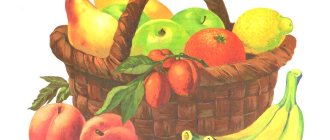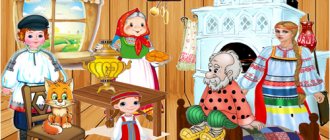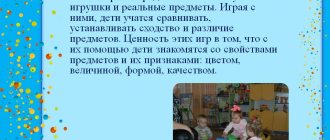Progress of the game:
Teacher Child
Whose tail is the fox's tail? Fox's tail
Whose ears are the hare's ears? bunny ears
Whose paws are the bear's paws? Bear paws
Mom's dress - whose dress is this? Mom's dress
Grandma's scarf - whose scarf is this? Grandmother's scarf, etc.
“Which one happens?”
Goal: selection of attributes for the subject, enrichment of the dictionary with adjectives
Progress of the game: the teacher asks: “What kind of apple is it?”
,children name the characteristics of the named object:
“round, red, sweet, sour, smooth, hard”
;
“What kind of kitten is there?”
—
“Small, fluffy, affectionate, kind”
“Find the exact word”
Goal: to teach children to accurately name an object, its qualities and actions.
- Find out what object I’m talking about: “Round, sweet, ruddy - what is it?”
(Items may differ from each other not only in taste, but also in size, color, shape).
- Complete with other words what I start: snow is white, cold. (what else)
.
Sugar is sweet and lemon is. (sour)
.
The weather is warm in spring and warm in winter. (cold)
.
-Name what things in the room are round, tall, low.
-Remember which of the animals moves how. Crow. (flies, fish. (swims, grasshopper. (jumps, snake. (crawls)
Which animal makes its voice?
Rooster. (crows, tiger. (growls, mouse. (squeaks, cow. (moos)
.
Game "One - Many"
Purpose: Differentiation of nouns in the nominative case, conversion from singular to plural.
Equipment: pictures with different objects.
Games and exercises for the formation of grammatical structure of speech in preschoolers
Card index of games and exercises for the formation of grammatical structure of speech in preschool children
2 Junior group
Contents: 1. A wonderful bag 2. A hint 3. What kind of dog is there? 4. Guess whose voice 5. “One is many” 1. WONDERFUL BAG Purpose: To focus on the gender of a noun when identifying an object by its characteristics. Equipment: Hare, carrot, cucumber, apple, tomato, bag. Progress of the game: Let's tell the children something like this: “A hare came to our kindergarten. Running bunny, what's in your bag? Can I have a look? What is this? (Carrot.) What carrot? (Long, red.) Put the carrots on the table. And what's that? (Cucumber.) What cucumber? (In the same way we take out a tomato, an apple, etc.) Now the hare wants to play with you. He hid all the vegetables and fruits in a bag. The bunny will put his paw into the bag, take a vegetable or fruit and tell you about it, and you must guess what the bunny has in his paw. Listen carefully. It is long and red. What is this? (Carrot.) It is green and long. What is this? (Cucumber.) It is round and red. What is this? (Apple.) It is round and red. What is this? (Tomato.)" If the children answer the last two questions incorrectly, we repeat, emphasizing the pronoun with our voice: "Listen again. It is round and red. It's round and red. Now find and put vegetables in the bag. What's left? (Apple.) Apples are fruits. Thank you, hare, for coming to us. Goodbye". 2. Prediction The game helps teach a child to finish a word and develops visual-figurative thinking. How to play: say with your child: Ko-ko-ko - the milk has run down on the stove... (ko). Sha-sha-sha - green gro... (sha). Chu-chu-well - pedal turn... (chu). Switch roles. The child says the syllables, you finish the word. For example, a child says: “Lo-,” - you finish: “-shad.” We fix it: we continue to play: puddle, chairs, window, car. If the child copes, invite him to add several endings to one syllable: no-zhnitsi, -gi, -ski. Whoever selects the most syllables wins. 3. What kind of dog is there? Goal:
Development of correct, competent speech, logical thinking.
You can ask the child to imagine a dog and tell him as much as possible about it: what kind of fur it has, what it likes to eat, what shape its tail and ears are, what its character is, etc. Children say the sentences one by one. Other topics: “What is spring like?”, “What is a cow like?” and so on. 4. Guess whose voice Goal
: To develop auditory attention in children, teach them to clearly pronounce polysyllabic words loudly and in a whisper, distinguish between words that sound similar, correctly place emphasis
Progress of the game:
Educator, imitating the voices of animals, i.e., pronouncing various sound combinations , invites children to guess who screams like that.
When the children guess and correctly name the animal, he asks them to determine whether the animal is large or small. For example, the teacher loudly says kva-kva-kva and asks: “Who is this?” Children: "Frog." Then the adult pronounces the same sound combination quietly. “Who is this?” he asks. Children: “This is a frog.” - “How did you know that this was a frog?” Children: “The little frog croaks quietly, and the frog croaks loudly.” The teacher ensures that all children listen carefully and answer questions correctly. 5. “One - many” PURPOSE: To train children in the formation of the plural of nouns in the nominative and genitive cases.
Teach the ability to listen to a peer and respond in a timely manner when it comes to the same subjects (middle, senior groups). GAME MATERIAL: paired pictures with images of toys, on one of which one object is drawn, and on the other - several of the same objects: balls, tumblers, pyramids, horses, trucks, bunnies. Progress of the game: first, the teacher lays out subject pictures depicting one object. The child makes up a simple sentence: “One duck”... etc. Then the teacher lays out pictures showing many objects. The child makes up a sentence: “A lot of ducks,” etc.. Middle group
Contents: 1. Game “Scrabble.” 2. Game exercise “Suggest actions.” 3Game “Who can name the most actions?” 4. Exercise “Name the first sound of the word” 5. “Make up a story” 1. Game “Scrabble”. Goal:
to consolidate the body parts of animals, and the formation of genitive case forms with the preposition U. Visual material: subject pictures.
Progress of the game
: children were given pictures of animals and asked questions.
Speech material: - Who has a big trunk? - Who has a fluffy tail? -Who has a pointed nose? - Who has long ears? - Who has hooves? 2. Game exercise “Suggest actions.” Game games and exercises to develop skills in the formation of prefixed verbs Goal:
to teach children to form and correctly use the verb GO with different prefixes.
Visual material: toy car. Progress of the game
: the experimenter showed actions with the machine and began sentences, and the children had to continue the sentences and name the action.
Speech material: - The car left the house (what did it do?) ... (DRIVEN AWAY); - The car is on the road...(It went); - The car is approaching the bridge... (DRIVED UP); - The car is on the bridge... (Drived); - The car drove off the bridge... (drove); - The car is a tree...(drove around). The experimenter repeated verbs pronounced correctly by the children, emphasizing the prefixes with his voice. 3. Game “Who can name the most actions.” Goal
: actively use verbs in speech, forming various verb forms.
Equipment: pictures: items of clothing, airplane, pen, sun, dog, bee, snowflake. Progress of the game:
The Incompetent comes and brings pictures.
The children's task is to choose words that denote actions related to objects or phenomena depicted in the pictures. For example, what can you say about an airplane? (it flies, buzzes, rises); what can you do with clothes? (wash, iron, sew up); what can we say about the sun? (warms, shines, rises); what can you do with the doll? (play, dress, put on shoes), etc. 4. Exercise “Name the first sound of the word” Educator. I have different pictures, let's name them (points to the pictures, the children take turns naming them). I'll tell you a secret: a word has a first sound with which it begins. Listen to how I name the object and highlight the first sound in the word: “Drum” - “b”; “Doll” - “k”; “Guitar” - “g”. Children take turns being called to the board, naming the object, emphasizing the first sound, and then the sound in isolation. 5. “Make a story” Goal:
Learn to write short stories about people of different professions;
Progress of the game:
Children learn to write stories about professions. The teacher gives an example: “This is a doctor. He heals people. He prescribes different medications for each patient. The doctor looks at the throat, listens, takes the temperature, gives injections. Following the model, children make up short stories from the pictures about the profession of a salesman, hairdresser, pilot, etc.
Senior group
Contents: 1. Game “Say Otherwise” 2. Game “Settle in the House” 3. Game “On the contrary” 4. “Reporter” 5. “Unravel the words” 1. Game “Say Otherwise” Purpose:
to teach children to select synonyms.
It's a dull time - dull, sad, dreary, gloomy, sad. The sky is gray - dark, cold, cloudy. Trees are naked - naked, naked (without leaves). The flowers dried up, withered and withered. Food - food, food, food. Long - long, long, long. Etc. 2. Game “Settle in the House” The goal
is to develop the ability to determine the syllable structure of a word.
The teacher introduces the “guests” using a riddle or something else and offers to place each guest in a house. At the same time, he draws the children’s attention to the fact that one house has a window with one sash, and the second one has two. To determine which guest has which house, you need to determine how many syllables are in the guest's name. If there is one syllable, then we put the guest in a house with one door. If there are two syllables, then we put the guest in a house with two doors. To complicate the game, you can then invite guests to a housewarming party and distribute them according to the same principle. 3. Game “On the contrary” Games to enrich vocabulary Purpose :
- exercise in the selection of antonyms (words - enemies).
Move:
It’s your turn to play the game “On the contrary”.
I will say the word “high”, and you will answer... (“low”). I will say the word “far”, and you will answer... (“close”). I will say the word “ceiling”, and you will answer (“floor”). I’ll say the word “lost”, and you’ll say (“found”)! I’ll tell you the word “coward”, you will answer... (“brave”). Now I’ll say “the beginning” - well, answer, ... (“the end”). 4. “Reporter” The child is given a toy microphone and answers the journalist’s questions. The teacher also has a microphone in his hands. Plan of questions: What is this? (Headdress …). What parts does it consist of? What colour? What time of year are they worn? Who dresses? (men, women, children). 5. “Unravel the words” Goal
: learn to compose sentences using these words.
Progress of the game:
The words in the sentence are mixed up. Try to put them in their place. What will happen? Suggestions for the game: 1. Smoke, coming, pipes, from. 2. Loves, little bear, honey. 3. Standing, in a vase, flowers, in.
Preparatory group
Contents: 1. “Animals” 2. “Count it up” 3. Games for the formation of complex words. 4. “My—my—mine—my” 5. “Think and name it.” 1. “Animals” Games for the formation of new words using suffixes. Purpose of the game
: form new words using suffixes.
Progress of the game: Bunny - bunny - bunny - bunny - bunny - bunny. Wolf - wolf cub - she-wolf - wolf - wolf. “House – house – house – house” Purpose
: to practice the formation of nouns using the suffixes -ik, -ishk, -ishche;
in the use of formed nouns in R.p.; develop the ability to hear grammatically correct speech. Material:
card divided into 4 parts, each of which contains images of a house, a house, a house and a house;
small cards of different colors (yellow, blue, red) with images of animals, furniture, dishes and other items available in the house; colored squares (3 pieces of each color) Progress
: 3 cards of different colors with animals or dishes, furniture, clothes, etc. are laid out next to the picture of a house.
The child is asked to name the objects and determine whether they can be in the house, house and house, connecting the names of the objects with a certain suffix. First, children independently perform the action, laying out the results of their solution in colored squares corresponding in color to cards with objects and animals, next to the image of different houses, then they explain their actions and name the resulting words. For example: “A hare and a cat can live in a house, because you can form the words “bunny” and “cat.” But the fox will not be able to live there, because... The word 'fox' doesn't exist." 2. “Count it up” Games for agreeing nouns with numerals in gender, number and case. Goal
: learn to form the plural of a noun.
For example: Counting to 5 with the word fox. One fox, two foxes, three foxes, four foxes, five foxes. You can count hares, bears, hedgehogs, etc. 3. Games for the formation of complex words. Goal
: teach children to form complex words from two simple words.
How to play: The chicken has a short tail - it is short-tailed. The goose has a white head - it is white-headed. The hare has long ears - he is long-eared. The heron has long legs - it is long-legged. 4. “My—my—my—my” Purpose:
an exercise in agreeing a pronoun with a noun.
1. An adult calls the children words and asks them to answer the question “whose?” (“whose?”, “whose?”, “whose?”), correctly agree the pronoun with the noun. Approximate speech material: ball, cube, bear, steamboat, horse, ball, airplane, stump, onion, tomato, pencil, bunny; car, doll, book, stroller, arrow, bee, plum, ribbon, shirt, box, stove; bucket, feather, wheel, ring, coat, dress, apple, cloud, mirror, tree, lake, sun; felt boots, shoes, mittens, boots, eyes, scissors, socks, eyebrows, books, friends. 2. An adult throws a ball to the child and says the word either “mine”, or “mine”, or “mine”, or “mine”. The child, returning the ball, says the correct word. 5. “Think and name it.” Purpose:
to exercise children in forming adjectives from nouns. We invite children to give the words the correct definitions. Sample answer: If there is dirt on the shirt, then the shirt is dirty. If there is difficulty, the question is asked “which one?” ("Which?"). Sample speech material: If it is very cold outside, then the day... If there is noise on the street, then the street... If a person is lucky, then the person... If a person has talent, then the person... If it rains all day, then the day... If a cow brings food to people benefit, then a cow... If a person has health, then a person...
We recommend watching:
Speech games for children Speech development in children. Tips for parents Games for developing the speech of preschoolers through improvisation The game is an exercise in the correct use of the verb want for children 5-6 years old
Similar articles:
Games for the development of speech breathing in the middle and senior groups
Speech development in children 3-4 years old with developmental disabilities based on Suteev’s fairy tales
Games for the development of attention and speech in children 4-6 years old
Letter games for children 4-6 years old
Tasks in pictures for speech development for children 3-5 years old
lexical and grammatical categories and word formation skills in children.
"Cut Pictures"
Target:
teach how to make a whole from two parts.
Equipment:
pictures “Apple” (horizontal section) and “Pear” (vertical section), cut into two parts.
Move.
The child is first presented with one picture. He folds it and names the resulting fruit. Then the baby makes up another picture. If this task does not cause difficulties for the child, you can immediately offer him the details of two pictures mixed together
LiveInternetLiveInternet
Wednesday, August 12, 2021 12:41 pm + in PEROOO
all posts by the author
| IN QUARANTINE WITH BENEFITS ———————————— Homework on the formation of the lexical and grammatical structure of speech and the development of coherent speech. FRUITS ********** For children 4-5 years old 1. Consider natural fruits with your child: apple, pear, peach, plum, grapes, apricot, orange, tangerine, lemon. Explain that all this can be called in one word “fruit”. 2. Pay attention to the characteristic features of fruits: taste, color, shape, smell. 3. If possible, show and tell where fruits grow (in the garden, on a tree). 4. Tell us what can be prepared from fruits. 5. Exercise on agreeing nouns with adjectives. “Name the color, shape.” Plum (which one?) - blue, oval. Lemon (which one?) - ... Apricot (which one?) - ... Etc. 6. Exercise “Count” to coordinate numerals with nouns. 1 lemon, 2 lemons, 3..., 4..., 5 lemons. 1 plum, 2..., 3..., 4..., 5... 1 apricot, 2..., 3..., 4..., 5... 1 pear, 2..., 3..., 4..., 5... Etc. 7. Exercise “Call it kindly” to form nouns using diminutive suffixes. Plum is cream. Apricot - apricot. Etc. 8. Exercise “One-many” on the use of nouns in the genitive plural. One orange - many oranges. One pear - many pears. Etc. 9. Exercise on forming the plural of a noun in the nominative case. Plum - plums. Apple - apples. Pear - pears. Etc. 10. Exercise “Complete the sentence” on the use of case forms of a noun. Mom bought fruit, washed it, and put it on a plate. We ate them with pleasure. We ate apples. There wasn't a single... (apple) left on the plate. We ate all... (apples). We ate pears. There wasn't a single... (pear) left on the plate. We ate all... (pears). We ate plums. There was not a single... (plum) left on the plate. We ate all... (plums). We ate cherries. There wasn't a single... (cherry) left on the plate. We ate all... (cherries). 11. Exercise “Name the jam” (learning to form relative adjectives). The jam was made from apples, it will be called... The jam was made from pears, it will be called... The jam was made from peaches, it will be called... The jam was made from cherries, it will be called... The jam was made from plums, it will be called... 12. Educational games " Find out by touch”, “Know by smell” for the development of tactile and taste sensations. Invite your child to recognize fruits by touch (smell) with his eyes closed. 13. Exercise “What grows where?” on the formation of cognate words. Apples grow on an apple tree. Pears grow on... Plums grow on... Etc. 14. Development of coherent oral speech. We learn to compose complex sentences with the conjunction “a” according to the model. Lemon is sour and apple is sweet. The lemon is oval and the apple is round. The lemon is yellow and the apple is green. (And so on with the example of all fruits.) 15. Development of logical thinking (learning to solve riddles). The size of a fist, red side. If you touch it with your finger, it’s smooth, and if you bite it, it’s sweet. (Apple) Balls hanging on the branches, Turned blue from the heat. (Plums) 16. Development of a small motor boat. Orientation on a sheet of paper. On the right half of the sheet draw 3-4 small fruits, and on the left half of the sheet draw 3-4 large fruits. Answer the question: “What did you draw?” (I drew an apple and an apple) If a child finds it difficult to draw fruits himself, then you can invite him to trace the fruit templates that you prepared in advance from thick cardboard. You can use stencils that are sold in stores or coloring books. 17. Development of fine motor skills. Exercises for fingers. We will cook compote. We need a lot of fruit. Here. (hold your left palm like a ladle, stir the compote with the index finger of your right hand) We will chop apples, we will chop pears. Squeeze out the lemon juice, add the drain and sand. (bend your fingers one at a time, starting with the thumb) Cook, we cook compote. Let's treat honest people. (hold your left palm like a “ladle”, use the index finger of your right hand to “stir” the compote) 18. Development of auditory memory. Learn a poem (any). V. Volina ********* Good autumn has come, It has brought us gifts: Fragrant apples, Fluffy peaches, Autumn has brought golden pears. The hedgehog brought three apples from the garden. He gave the most rosy thing to Belka. Etc. PEROOO |
[/td]
Series of messages “Development and correction of speech”:
Part 1 - Causes of speech disorders Part 2 - What speech problems should you go to a speech therapist with... Part 19 - WHY YOU CAN’T WAIT IF A CHILD HAS NO SPEECH AT 2 YEARS OLD Part 20 - ABC BY ABC. Selection: Speech therapy ABC Part 21 - Homework on the formation of the lexical and grammatical structure of speech and the development of coherent speech. FRUITS
| Categories: | CHILDREN'S LIBRARY/Speech development Reading Primers |
Tags:
children coherent speech fruits
Cited 9 times Liked by: 6 users
Like share
0
Like
- 6
I liked the post - Quoted
- 0
Saved
- Add to quote book
- 0
Save to links
Liked6
0





